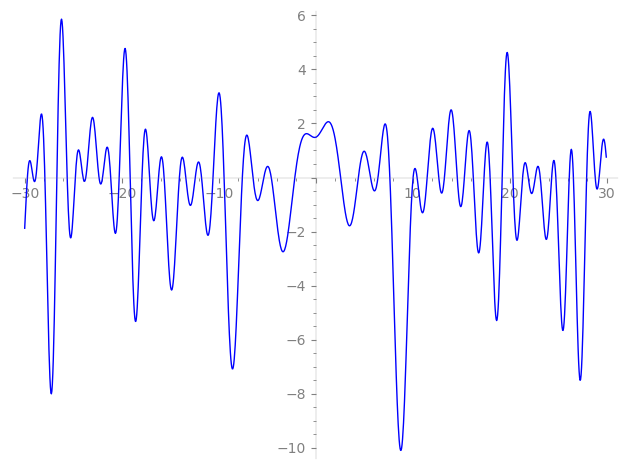| L(s) = 1 | + (1.41 + 0.0941i)2-s + (−1.68 − 0.416i)3-s + (1.98 + 0.265i)4-s + (1.62 − 1.54i)5-s + (−2.33 − 0.746i)6-s + (−0.361 + 0.361i)7-s + (2.77 + 0.561i)8-s + (2.65 + 1.40i)9-s + (2.43 − 2.02i)10-s − 2.63·11-s + (−3.22 − 1.27i)12-s + (−3.49 + 3.49i)13-s + (−0.544 + 0.476i)14-s + (−3.36 + 1.91i)15-s + (3.85 + 1.05i)16-s + (−3.61 − 3.61i)17-s + ⋯ |
| L(s) = 1 | + (0.997 + 0.0665i)2-s + (−0.970 − 0.240i)3-s + (0.991 + 0.132i)4-s + (0.724 − 0.688i)5-s + (−0.952 − 0.304i)6-s + (−0.136 + 0.136i)7-s + (0.980 + 0.198i)8-s + (0.884 + 0.466i)9-s + (0.769 − 0.638i)10-s − 0.794·11-s + (−0.930 − 0.367i)12-s + (−0.968 + 0.968i)13-s + (−0.145 + 0.127i)14-s + (−0.869 + 0.494i)15-s + (0.964 + 0.263i)16-s + (−0.876 − 0.876i)17-s + ⋯ |
Λ(s)=(=(120s/2ΓC(s)L(s)(0.972+0.234i)Λ(2−s)
Λ(s)=(=(120s/2ΓC(s+1/2)L(s)(0.972+0.234i)Λ(1−s)
| Degree: |
2 |
| Conductor: |
120
= 23⋅3⋅5
|
| Sign: |
0.972+0.234i
|
| Analytic conductor: |
0.958204 |
| Root analytic conductor: |
0.978879 |
| Motivic weight: |
1 |
| Rational: |
no |
| Arithmetic: |
yes |
| Character: |
χ120(53,⋅)
|
| Primitive: |
yes
|
| Self-dual: |
no
|
| Analytic rank: |
0
|
| Selberg data: |
(2, 120, ( :1/2), 0.972+0.234i)
|
Particular Values
| L(1) |
≈ |
1.47925−0.175761i |
| L(21) |
≈ |
1.47925−0.175761i |
| L(23) |
|
not available |
| L(1) |
|
not available |
L(s)=p∏Fp(p−s)−1 | p | Fp(T) |
|---|
| bad | 2 | 1+(−1.41−0.0941i)T |
| 3 | 1+(1.68+0.416i)T |
| 5 | 1+(−1.62+1.54i)T |
| good | 7 | 1+(0.361−0.361i)T−7iT2 |
| 11 | 1+2.63T+11T2 |
| 13 | 1+(3.49−3.49i)T−13iT2 |
| 17 | 1+(3.61+3.61i)T+17iT2 |
| 19 | 1−0.672T+19T2 |
| 23 | 1+(4.31−4.31i)T−23iT2 |
| 29 | 1−4.76iT−29T2 |
| 31 | 1−3.73T+31T2 |
| 37 | 1+(−2.82−2.82i)T+37iT2 |
| 41 | 1+4.10iT−41T2 |
| 43 | 1+(−7.57+7.57i)T−43iT2 |
| 47 | 1+(0.987+0.987i)T+47iT2 |
| 53 | 1+(0.646+0.646i)T+53iT2 |
| 59 | 1+4.92iT−59T2 |
| 61 | 1+6.07iT−61T2 |
| 67 | 1+(−0.349−0.349i)T+67iT2 |
| 71 | 1+8.63iT−71T2 |
| 73 | 1+(11.3+11.3i)T+73iT2 |
| 79 | 1−4.07iT−79T2 |
| 83 | 1+(−8.53−8.53i)T+83iT2 |
| 89 | 1−6.58T+89T2 |
| 97 | 1+(0.660−0.660i)T−97iT2 |
| show more | |
| show less | |
L(s)=p∏ j=1∏2(1−αj,pp−s)−1
Imaginary part of the first few zeros on the critical line
−13.39005039574373496318138410567, −12.41765741514241666190778776085, −11.76829120942313902485500131948, −10.58649482070175993340597522348, −9.445867724157522922402985093476, −7.56438374791888586325921907142, −6.47052091506511208879437123507, −5.35488946864313463135466148459, −4.58305846880449325612744215944, −2.15523670621358233049512183517,
2.56635425807087230973151481604, 4.39229959424836275096459909554, 5.65010560185608275944114146847, 6.41656676754295628925680577809, 7.64158520779358682973407520603, 10.03741051194394526131518942214, 10.45145047676257193748751156965, 11.48475266298251613884225277167, 12.68406320949440557910723493442, 13.26671572515331130111905494450

